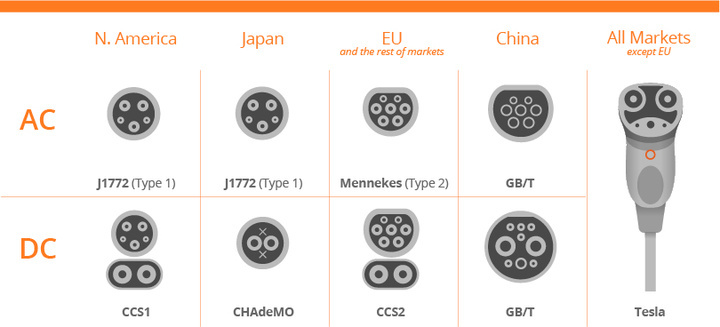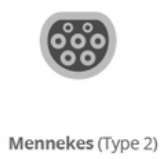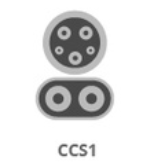First of all, the charging connectors divided into DC connector and AC connector. DC connectors are with high-current, high-power charging, which are generally equipped with fast charging stations for new energy vehicles. Households are generally AC charging piles, or portable charging cables.
1. AC EV Charging Connectors

There are mainly three types, type 1, type 2, GB/T, which can also be called American standard, European standard and National standard. Of course, Tesla has its own standard charging interface, but under pressure, Tesla also began to change its own standards depending on the market situation to make its cars more suitable for the markets, just like domestic Tesla must be equipped with national standard charging port.

①Type 1: SAE J1772 interface, also known as J-connector
Basically, the United States and countries with close ties to the United States (such as Japan and South Korea) use Type 1 American standard charging guns, including portable charging guns carried by AC charging piles. Therefore, in order to adapt to this standard charging interface, Tesla also had to provide a charging adapter so that Tesla cars can use the public charging pile of the Type 1 charging port.
Type 1 provides mainly two charging voltages, 120V (Level 1) and 240V (Level 2)

②Type 2: IEC 62196 interface
Type 2 is the new energy vehicle interface standard in Europe, and the rated voltage is generally 230V. Looking at the picture, it may be a bit similar to the national standard. In fact, it is easy to distinguish. The European standard is similar to the positive engraving, and the black part is hollowed out, which is the opposite of the national standard.

From January 1, 2016, my country stipulates that as long as the charging ports of all brands of new energy vehicles produced in China must meet the national standard GB/T20234, so the new energy vehicles produced in China after 2016 do not need to consider the charging port suitable for them. The problem of not adapting to the national standard, because the standard has been unified.
The rated voltage of the national standard AC charger is generally 220V household voltage.

2. DC EV Charging Connector
DC EV Charging Connectors generally correspond to AC EV Connectors, and each region has its own standards, with the exception of Japan. The DC charging port in Japan is CHAdeMO. Of course, not all Japanese cars use this DC charging port, and only some new energy vehicles from Mitsubishi and Nissan use the following CHAdeMO DC charging port.

Others are American Standard Type 1 corresponding to CCS1: mainly add a pair of high-current charging holes below.

European standard Type 1 corresponds to CCS2:

And of course our own DC charging standard:
The rated voltage of DC charging piles is generally above 400V, and the current reaches several hundred amperes, so generally speaking, it is not for household use. It may only be used in fast charging stations such as shopping malls and gas stations.
Post time: May-30-2023
